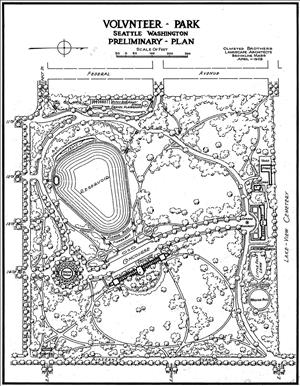By 1903, Seattle had five major public parks but city officials wanted more. They hired the Olmsted Brothers, a landscape architecture company from Massachusetts, to help create more parks. John C. Olmsted came to Seattle to explore the area, identify special places and natural resources, and design a great system of parks and boulevards for residents and visitors. (This essay was written for students in third and fourth grade who are studying Washington State History and for all beginning readers who want to learn more about Washington. It is one of a set of essays called HistoryLink Elementary, all based on existing HistoryLink essays.)
More Parks for a Growing City
By the early years of the twentieth century, Seattle had become a large city. In only 50 years, it had grown from a group of pioneer cabins to a city of nearly 100,000 people. Money earned from the Klondike Gold Rush had helped to build many new businesses and homes. Seattle was now one of the most important cities on the West Coast.
People of Seattle and King County were very proud to live and work in an area surrounded by such natural beauty. By 1903, the city government had already established five major public parks (Denny, Kinnear, Volunteer, Washington, and Woodland). City officials wanted everyone to be able to enjoy grand scenery and peaceful surroundings. Soon the Seattle City Council decided that there should be an even more complete set of parks for the growing city. So they hired the Olmsted Brothers from Brookline, Massachusetts, to help with that project. The Olmsteds were well-known in the field of landscaping. They had developed important parks such as New York's Central Park, the capitol grounds in Washington D.C., and the park system in Portland, Oregon.
John Charles Olmsted was the firm's senior partner. Soon after he was hired, he came to Seattle to conduct a survey. He and his assistant, Percy Jones, explored Seattle by horse, trolley, foot, and boat. While he was away from his family, Olmsted often wrote letters to his wife Sophie. He told her of the wonderful natural resources of this region. In his letters, he also described what he wanted the citizens of Seattle to be able to see and appreciate from different parts of the city. When he was done with his survey, Olmsted prepared a detailed plan for the park system of Seattle. He made sure to include all the points that he had written about in his letters home.
In his report, Olmsted urged the city to obtain as much land as possible. He wanted to make sure that it could be shared by all those who lived, worked, or visited Seattle. He wrote that it was important that land for parks be on or near every body of water within the city limits. He was afraid all of the most valuable land would be purchased by wealthy people to build their own personal homes.
Another important point in his report to the city was that the parks should include playgrounds. Olmsted recommended that the city develop a park within one-half mile of every home in Seattle. He wanted young children and women with babies to have a park near their houses. He planned for outdoor playground equipment to be built in the parks for older boys and girls.
Olmsted told the City Council that every park should be different. He designed each one to take advantage of the individual natural resources and views that he first noticed when he selected the park location. The Olmsted park system was planned so that the parks and boulevards would be connected along 20 miles of shorelines. This route included parks on Seattle's major lakes (Green Lake, Lake Washington, and Lake Union) as well as on Puget Sound. Olmsted also agreed with city leaders who wanted to lower the water in Lake Washington by several feet. He knew that this would create more shoreland for parks.
Over a 30-year time period, the Olmsted Brothers firm designed 37 parks and playfields for Seattle. During this time, they also designed more than 200 gardens for private-property owners in the Northwest. Olmsted also designed the landscape on the University of Washington campus for the 1909 Seattle World's Fair -- the Alaska-Yukon-Pacific-Exposition. Visitors from all around the world were impressed by the beautiful scenery that surrounded the host city.
Current citizens and visitors to Seattle all have reasons to be grateful to the Olmsted Brothers. More than 100 years ago, they thought ahead for future generations. They planned a system of parks and boulevards where everyone can enjoy the amazing views of the mountains, water, and forests that surround the city.

